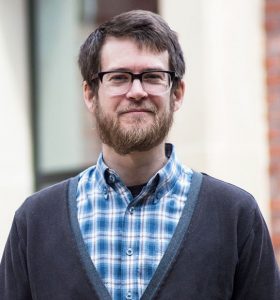Tom Astley, Teacher
School of Arts and Cultures
Humanities and Social Sciences
What did you do?
Gave ongoing feedback to students throughout the module to help improve their communication and reflective skills.
Who is involved?
Tom Astley, Teacher, Arts and Cultures.
Students on the Jazz Improvisation and Compositions in Theory and Practice module.

Tom Astley, School of Arts and Cultures
How do you do it?
This semester I was lucky enough to be module leader on the Jazz Improvisation and Compositions in Theory and Practice module. Assessment and feedback is such an important aspect of any module and I wanted to approach it in a way that was constructive, ongoing and multi-modal.
The ultimate outcome of the assessment process was the students performing at the Jazz Café in Newcastle but I was as interested in how they got there as I was in the end result, which happened to be pretty impressive.
I started by filming the students practicing their performance pieces. While I was watching them I would note down questions based on their performance and other issues I wanted them to reflect on. The videos were uploaded to YouTube and I sent through the link with a list of the questions that I had. Students then used these in a way that helped them. If they had quite a personal response they would get back to me directly but often they shared their responses with the group. I also encouraged them to ask further questions of themselves and each other, to encourage their communication and reflective skills.
As well as the final performance, students produced a reflective piece of work and in partnership with the students we agreed that there should be some autonomy with the format of that. It might have been a diary, a detailed answer to one of the questions I had posed throughout the module and one student even produced an audio commentary in the form of a performance.
This highlights that having some freedom in assessment can increase creativity and also encourage students to think about themselves and what their strengths are. To increase their self-reflection even more, when it came to their final mark I asked students to critically reflect on their performance and identify what mark they thought they should receive. We then discussed why I had arrived at my mark and why they had arrived at theirs. Interestingly, students always marked themselves lower than the mark I gave them.
Why do you do it?
I wanted to move away from a more traditional approach to feedback where the lecturer gives feedback at the end of the assessment and then the students act upon it for their next assessment. My aim was to give continuous feedback and, not only that, but for students to challenge this and come back and ask more questions, to feedback to their peers and to reflect themselves.
In many subject areas there is an element of subjectivity when marking assessments and I didn’t want the mark just to reflect the final performance but to represent the hard work and improvements that students made to get to that. I wanted to take a holistic view of the individual student’s development and look at their communication skills and ability to critically reflect on their own work.
Does it work?
For me the success of this approach is best evidenced by the improvement that I could see in the way that students communicated with each other during the rehearsals. I could easily compare the videos right from the start of the semester to those at the end. The improvements in working together and the ability to reflect stood out to me. These transferable skills will benefit the students as they continue through their studies and into their careers.
I also won the award for ‘Outstanding Contribution to Feedback’ at the Teaching Excellence Awards this year. Reading the comments from the students definitely helped me realise I must be on the right track with this approach and I’m glad they got so much out of it.
Contact details
